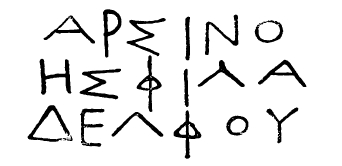
PHRC048 : Dedication to Arsinoe Philadelphos, Karpasia (?) - Cyprus (270-240 BC) Dedication
Permanent ID http://s.phrc.it/phrc048
Images
Photo 1: Drawing of the inscription, from Perdrizet 1896, p. 359

Text constituted from: Perdrizet 1896, p. 359, no. 9.
Other editions:
See also: Perdrizet 1906, p. 156; Mitford 1983, p. 30-31, cat. e; Robert 1966, p. 204; Nicolaou 1993, p. 227, cat. s; Anastassiades 1998, nr. 24; Caneva 2014a, no. 33; Caneva 2020.
Images: Perdrizet 1896, p. 359 (drawing of the inscription).
Further bibliography:
Online record: PHI
If we accept the measures given by the editor Perdrizet, this stone, now lost, provides the biggest support inscribed with the genitive dedication ‘Of Arsinoe Philadelphos’ known from our sources. The separation of the text in three lines disregarding the word ending suggests that the text occupied the whole width of the stone. Since Perdrizet described the block as a large cippus (therefore with height exceeding width), it is possible to use the known size of letters (8 cm for Φ, 3 cm for O) to reconstruct a surface of about 54 cm width, while the block must have been considerably higher, possibly up to 1 m.
Perdrizet’s description as a large cippus was corrected by Mitford, who also saw the stone when it was still incorporated into the wall of a private reservoir in the Kalogero village of the Karpaz peninsula. Mitford 1938, p. 31 and n. 1 pointed out that the stone “is not as might be inferred from Perdrizet cut on a cylindrical cippus of the usual Cypriot type.” According to him, it was a stele comparable with one reused in a wall at the entrance of Limassol (Perdrizet 1896, p. 358-359, no. 8). By combining these indications we may propose that the Yalousa stone was a large rectangular block similar to a specimen from Palaepaphos ( PHRC034) and to one recently excavated near Halikarnassos (Diler et al. 2010, p. 193.194), and that Mitford’s interpretation as a stele depended on the fact that he could not precisely evaluate the depth of the stone since it was reused inside a wall. The size and vertical orientation of these stones, together with the absence of moulded cornices in the preserved specimens from the Paphos and Halikarnassos areas, allow us to exclude their use as altars and rather point to an interpretation as architectural elements. These inscribed blocks would have been part of a wall or might have stood alone, functioning as horoi delimiting a sacred enclosure dedicated to the cult of Arsinoe Philadelphos (Caneva 2020). The original setting of the stone is lost, but the block plausibly belonged to a public building, probably a local sanctuary, situated in the territory of Karpasia. The hypothesis that the Yalousa block was a horos was already expressed by Perdrizet 1906, p. 156, who, however, erroneously intepreted the delimited plot of land as a possession of the living Arsinoe rather than as a sacred space dedicated to the cult of the deceased and deified queen.



